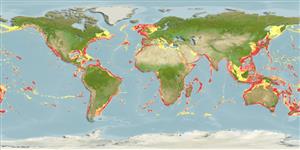Common names from other countries
Environment: milieu / climate zone / depth range / distribution range
Écologie
Benthopélagique; profondeur 0 - 2200 m (Ref. 275). Subtropical; 10°C - 24°C (Ref. 275), preferred 25°C (Ref. 107945); 79°N - 48°S, 180°W - 180°E
Circumglobal in subtropical and polar oceanic waters.
Length at first maturity / Taille / Poids / Âge
Maturity: Lm ?, range 40 - ? cm Max length : 45.0 cm ML mâle / non sexé; (Ref. 97142); 90 cm ML (female); poids max. publié: 1.8 kg (Ref. 275); âge max. reporté: 1.00 années (Ref. 77103)
Caught by dipnets (Ref. 417). Maximum depth from Ref. 59712. Oceanic but occurs near the surface at night (Ref. 417). Occasionally washed up on the beaches (Ref. 88739).
Life cycle and mating behavior
Maturité | Reproduction | Frai | Œufs | Fécondité | Larves
Members of the class Cephalopoda are gonochoric. Male and female adults usually die shortly after spawning and brooding, respectively. Mating behavior: Males perform various displays to attract potential females for copulation. During copulation, male grasp the female and inserts the hectocotylus into the female's mantle cavity where fertilization usually occurs. Life cycle: Embryos hatch into planktonic stage and live for some time before they grow larger and take up a benthic existence as adults.
Roper, C.F.E., M.J. Sweeney and C.E. Nauen. 1984. (Ref. 275)
Statut dans la liste rouge de l'IUCN (Ref. 130435)
statut CITES (Ref. 108899)
Not Evaluated
Not Evaluated
Utilisations par l'homme
Pêcheries: commercial
FAO - pêcheries: landings | FishSource | Sea Around Us
Outils
Sources Internet
Estimates based on models
Preferred temperature
(Ref.
115969): 5.7 - 17.2, mean 10.4 (based on 1723 cells).
Prior r = 0.51, 95% CL = 0.34 - 0.76, Based on 1 full stock assessment.
